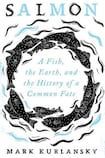
Mark Kurlansky, who has previously authored compendia on topics including Cod and Salt, here switches focus to chronicle the demise of the storied salmon throughout its wide Pacific and Atlantic ranges.
Apart from a few whimsical meanders into a history of fly-tying and samples of salmon recipes from various cultures, it is a brutal and stark account of the relentless pressures generated by a grand “Manifest Destiny” mentality which accepts the extinction of an ancient icon as a small, hardly accountable cost to achieve the ambitions of hydro power, forestry exploitation, urbanisation, mining, irrigation et al.
We are taken on a tour of how zoologists consider salmon to be a “keystone species”, as not only is their presence proof of the viability of an entire suite of similarly pollution-intolerant species “below” them (from microscopic diatoms through to aquatic insects and other fish species) but that they also represent key nutrition for many species “above” them including bears, wolves, seals, orcas, otters, and birds of prey.
Because of the anadromous (inhabiting both fresh and salt waters) nature of salmon, the spoils of this diet provide important dispersal of marine minerals across the landscape. These catalyse the formation of a complex mosaic of woodlands, wildflower meadows and other habitats, which then moderate the pristine streams and rivers which serve as nursery for the salmon. This is the Gaia theory in a nutshell; that all life and habitat develops as one grand organism to shape and perpetuate all denizens in an ever-evolving arc which is able to intelligently respond, through the ages, to climate change or cataclysmic upheaval (volcano, earthquake, landslide, etc).
Enter man. Across diverse geographies, from the Japanese archipelago across the Aleutians, from the St Lawrence to the Columbia, and the Rhine to the Loire, Kurlansky takes us through Old Testament-inspired decision-making processes which, though achieving a transient wealth for human communities, inadvertently and systematically unravels this profound tapestry of nature.
Interdependencies
An interesting subtext throughout is Kurlansky’s depiction of the practices in salmon catchments around the northern hemisphere of First Nation people and whose lives were intertwined with salmon. These cultures include the Ainu of Japan, the indigenous peoples of Kamchatka and the Bering Sea, the more southerly tribes of the Pacific northwest and what is now Atlantic Canada; the Sami of Finland, and the Aboriginals of Scotland and Ireland.
Common to all of these otherwise disparate peoples was an awareness and acknowledgement of the interdependencies of the natural world, a reverence for all species (with salmon often as pinnacle) upon which human nutrition and welfare depended, and a way of life informed by the desire for a permanent relationship with the Earth.
If you lose your salmon, do you lose your soul? In the context of wide and current extinction of so many species, this book is a timely reminder that we should be tempering our economic models and eschewing fabricated glitter in favour of a re-elevation of Fionn mac Cumhaill and the Salmon of Knowledge as touchstones of our society; and to cultivate and communicate the value of having vibrant wild salmon runs in our midst.
Mark Boyden is StreamScapes education director with Coomhola Salmon Trust and Cathaoirleach of the Sustainable Water Network












